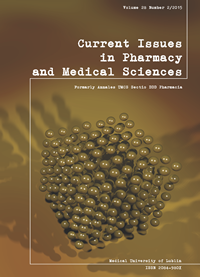Eudragit FS 30D as a potential polymer for use in the technology of preparing matrix tablets contain metronidazole – an experimental and mathematical modeling study
DOI:
https://doi.org/10.1515/cipms-2015-0053Keywords:
matrix tablets, metronidazole, Eudragit FSAbstract
The aim of this study was to examine the usefulness of a pH-dependent copolymer - Eudragit FS - for employment in the technology of preparing modified release metronidazole matrix tablets. In addition, in our work, Eudragit RL and Eudragit RS were included in the composition of some formulations, as well as sodium lauryl sulfate and polysorbate 80. As part of the study of the dissolution test, the similarity coefficient (f2) for the obtained profiles was calculated, and mathematic models were used to estimate the kinetics and mechanism of active substance release. In our work, it was observed that the inclusion of polymer Eudragit FS alone in the tablet composition ensured a modified release of the active substance for 10 h. After this time period, the amount of metronidazole determined in the acceptor fluid was 71% - 81% of the declared dose. Modification of the composition by the addition of surfactants resulted in an increased release of the active substance of up to 98%. This effect was dependent on the type of surfactant and its quantitative ratio to the Eudragit FS. Similar release profiles were obtained for tablets containing Eudragit RS and sodium lauryl sulfate, as well as Eudragit RS and polysorbate 80. Depending on the composition of tablets, metronidazole release proceeded in accordance with either first or second-order kinetics. We calculated as well, that the differing masses of Eudragit FS in the studied formulations correlates with the order of release kinetics (p < 0.002). Such an effect was validated using the Weibull model, wherein, in all the studied formulations, the release rate was seen as a decreasing function of time. An analysis of data according to the Ritger-Peppas model and the Peppas-Sahlin model for some formulations, indicated that the mechanism of active substance release from matrix tablets is diffusion.
References
1. Brunton L.L., Lazo J.S., Parker K.L.: Goodman and Gilman’s: the pharmacological basis of therapeutics, 11th ed. New York: McGraw-Hill, 2006.
2. Campos-Aldrete M.E., Villafuerte-Robles L.: Influence of the viscosity grade and particle size of HPMC on metronidazole release from matrix tablets. Eur. J. Pharm. Biopharm., 43, 173, 1997.
3. Draper N.R., Smith H.: Applied Regression Analysis, John Wiley & Sons Inc., 1998
4. Evonik. Eudragit® Application Guidelines, http://eudragit.evonik.com/, 2009.
5. Godfrey R., Edwards R.: A chromatographic and spectroscopic study of photo-degraded metronidazole in aqueous solution. J. Pharm. Sci., 80, 212, 1991.
6. Gupta V.K. et al.: A novel pH- and time-based multi-unit potential colonic drug delivery system. II. Optimization of multiple response variables. Int. J. Pharm., 213, 93, 2001.
7. ICH Guideline. Q2 (R1) (2005) Validation of analytical procedures: text and methodology. International Conference on Harmonization. Vol. 6. 1996.
8. Lehmann K., Dreher D.: Mischbarkeit wässriger Poly(meth)acrylat-Dispersionen für Arzneimittelüberzüge. Pharmaz. Ind., 48,1182,1986.
9. Lindenberg M., Kopp S., Dressma J.B.: Classification of orally administered drugs on the World Health Organization Model list of Essential Medicines according to the biopharmaceutics classification system. Eur. J. Pharm. Biopharm., 58, 265, 2004.
10. Moore J.W., Flanner H.H.: Mathematical comparison of curves with emphasis on in vitro dissolution profiles. Pharm. Techn., 20, 64, 1996.
11. Moustafine R.I. et al.: Drug release modification by Interpolymer interaction between countercharged types of Eudragit RL 30D and FS 30D in double – layer films. Int. J. Pharm., 439,17, 2012.
12. Mustafin R.I.: Interpolymer Combinations of Chemically Complementary Grades of Eudragit copolymers: A new direction in the design of peroral solid dosage forms of drug delivery systems with controlled release (review). Pharm. Chem. J., 45, 285, 2011.
13. Otsuka M., Matsuda Y.: Effect of co-grinding time on the release of pentoxyfylline from waxy matrix tablets. J. Pharm. Sci., 83, 956, 1994.
14. Ozyazici M., Gökçe E.H., Ertan G.: Release and diffusional modelling of metronidazole lipid matrices. Eur. J. Pharm. Biopharm., 63, 331, 2006.
15. Remington J.P.: Remington: The science and practice of pharmacy. Eds. David B. Troy, and Paul Beringer. Vol. 1. Lippincott Williams & Wilkins, electronic version. London: Pharmaceutical Press, 2006.
16. Sato H. et al.: Dissolution mechanism of diclofenac sodium from wax matrix granules. J. Pharm. Sci., 86, 929, 1997.
17. Serra L., Domenech J., Peppas N.A.: Drug transport mechanism and release kinetics from molecularly designed poly(acrylic acid-g-ethylene glycol) hydrogels. Biomaterials, 27, 5440, 2006.
18. Shi D. (ed.). Biomedical devices and their applications. Springer, 2004.
19. Siepmann J., Peppas N.A.: Modeling of drug release from delivery systems based on hydroxypropyl methylcellulose (HPMC). Adv. Drug Deliv. Rev., 48, 139, 2001.
20. Szente V, Baska F, Zelkó R, Suvegh K. Prediction of the drug release stability of different polymeric matrix tablets containing metronidazole. J. Pharm. Biomed. Anal., 54(4): 730-4, 2011.
21. The Merck Index. Fourteenth Edition, Whitehouse Station, NJ: Merck & Co., electronic version, 2006.
22. United States Pharmacopoeia/National Formulary, 32/27, Rockville, MD: Pharmacopeial Convention; 2009
23. Viridén A. et al.: Model drug release from matrix tablets composed of HPMC with different substituent heterogeneity. Int. J. Pharm., 401, 60, 2010.
24. Viridén A., Wittgren B., Larsson A.: Investigation of critical polymer properties for polymer release and swelling of HPMC matrix tablets. Eur. J. Pharm. Sci., 36, 297, 2009.
25. Zhang Y. et al.: DDSolver: An add-in program for modeling and comparison of drug dissolutions profiles. AAPS J, 12, 263, 2010.
Downloads
Published
Issue
Section
License
Copyright (c) 2015 Authors

This work is licensed under a Creative Commons Attribution-NonCommercial-NoDerivatives 3.0 Unported License.


